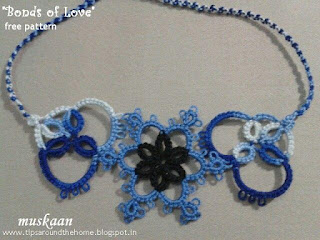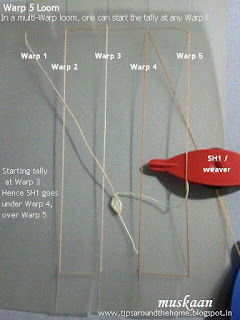YES, I wanted to share a rakhi/bracelet pattern for Raksha
Bandhan.
One adapted pattern was ready during the Curled Rings phase in May (just didn’t get around to posting it). 2nd
pattern was made during the Cluny
Then one evening, while sorting out my tinies, putting them
in another compartmentalized box, I began playing around with them. And thus
was hatched another quick pattern which could work so well as a rakhi.
NO, I did not think of ‘bonding’ per se. But it was serendipity !!! Both patterns are a bonding of 2
very different patterns .
Raksha Bandhan is
celebrated traditionally by sister tying a rakhi on a brother’s wrist – a
symbolic bond/undertaking. Literally, it can translate to ‘protection bond/binding’.
Since we didn’t have a brother & Mom didn’t want us to feel ‘left out’, we
tied it on our Dad’s wrist – he was, after all, the protector of our family!
There are a lot of interesting historical episodes where non-relative bonding
was resorted to, as a means of keeping the peace, seeking protection, joining
of families/clans, etc. In recent years, the symbolism has extended to tying the band
on wrists of soldiers & other protectors of law & order.
I wonder if feminists have a gender perspective on this ?
Hmm ….
Bonding a Snowflake with 2 Hearts (click for pattern)
A snowflake medallion
in centre & a heart on the side
looked good & the colours worked too. Quickly tatted up another heart &
added the strings. Loved the symbolism of the hearts. And a good way to use up
some of the motifs lying around.
Together,
the 3 measure 3½” in length & about 1½” in width.
Anchor
Mercer Cotton size 20 : Black, Blue – 0131, Variegated Blue – 4054-1210
Techniques
Used : Thrown rings (rings on chain), reverse stitch (rs) (unflipped double
stitch), Josephine Knot, Long Picot (LP).
Hexagonal Snowflake : a 2-shuttle pattern with thrown
rings & 2 colours.
Magic Heart : 1 shuttle & ball, or 2-shuttles
with only one small Josephine Knot on chain.
Strings : 2-shuttles [1ds, 1rs] repeat to
desired length .
Tassels : optional
ds – double stitch ; rs – reverse
stitch or unflipped ds or 2nd half of split ring stitch.
Depending
on the colours one uses, it can be tatted in either 2 or 3 segments, joining as
you go.
Version
1 : Make snowflake. Cut & hide
ends. Start a heart at the base, climb up left side, join to snowflake at
center, continue down right side. End with string to desired length. Repeat for
2nd heart at opposite end
of snowflake.
Version
2 : Make 2 hearts
along with the strings. Then start snowflake & join to hearts at opposite
ends. Cut & hide ends.
Version
3 : Make one heart
with string. Start snowflake & midways join to heart. Complete the
snowflake, climbing out with a split thrown ring & mock picot & start
the 2nd heart.
Since 2 of the 3 medallions were already in my stash, I did
not add any beads. But beads & pearls would enhance the look, especially if
used for Jewelery, either as a bracelet or a choker.
As you can see, it is a versatile combo -- use any motifs
that one has lying around.
If one adds the string to only one side, it can be used as a
Bookmark.
 |
| Choker ?! |
Download Pattern here : “ Bonds of Love ”
I have inked the stitch counts on the diagram ;
●●●●●●@@@@@@@●●●●●●
“Blossoming
Bonds” Rakhi / Bracelet
Bonding a layered flower with a leafy braid ;
also 2D – 3D
bonding & freefrom with regular/symmetry bonding
Flower is
>1” across. Length of bracelet/rakhi : 7” (12-13 repeats)
Red Heart
Perle Cotton size 20 : Yellow – 0307 ; Rust Brown – 0341
Anchor
Mercer Cotton size 20 : Green – 4054-0241
Techniques
Used : Split Ring, Floating Chain/Curlicue, Auxiliary Thread tatting, Josephine
Ring (optional), Curled Ring (optional)
Bead(s) as
required. Findings as required.
Center
Flower : I started
out by making Jennifer Williams’ “Flower using Two Layered Tatting” here. But didn’t notice that the joining picots
were to be very small ! Hence, decided to stop & do some course-correction
to limit my losses.
Instead of 7 repeats for each layer, I made 4 for inner
& 5 for outer layers, keeping the original stitch-count .
Add a
bead in centre (& wherever required) (I had to add the bead later)
Thus it
was converted into a rakhi or a bracelet.
Braid : The Leaf Braid, here, as modernized by Jane McLellan was on my
to-tat list as well & thought it would make a nice foliage-y addition to
the flower, instead of the usual strings.
1. Start the
braid with a Josephine Ring (or a
finding): 30 hs at one end
2. Midway
through the braid, attach it to one end of a petal & also add an auxiliary
thread to make the buds. Made one bud, with picoted calyx and add a dead-end curlicue.
3. Bud #1 : (3 vsp 4 p 4 vsp 3 ) x 3 . Join
to adjacent picot & top picot *.
4. Calyx : A short chain with picots,
curled around the base of each bud & joined to base.
5. Tendril : 1 dead-end curlicue till desired
curl is obtained.
 |
| Using Curled Ring for Bracelet Clasp |
6. Continue
across & under the main flower, anchoring at a couple more points.
7. Make another
bud at the other end, diagonally from the first bud.
Bud #2 : (4 vsp 3 p 3 vsp 4 ) x 3 . Join
to adjacent picot & top picot *.
8. Tat over
auxiliary thread to hide tail, continuing with the braid till desired length.
9. End with a
Curled Ring (Option 2) at end (or a
finding/clasp) : Ring 12 vsp 12, curl.
10. Cut &
hide ends.
* NOTE : When making the buds, it is easier to make & join the ‘petals’ at the side picot of previous ring. When making the last ring, pass thread through top picots of earlier rings at same time.
Since this is an adapted pattern, I have not shared the stitchcount
here. Please visit the respective sites/blogs for free pattern :
Two Layer Tatting
by Jennifer Williams
Leaf Braid by
Jane McLellan
●●●●●●@@@@@@@●●●●●●
















